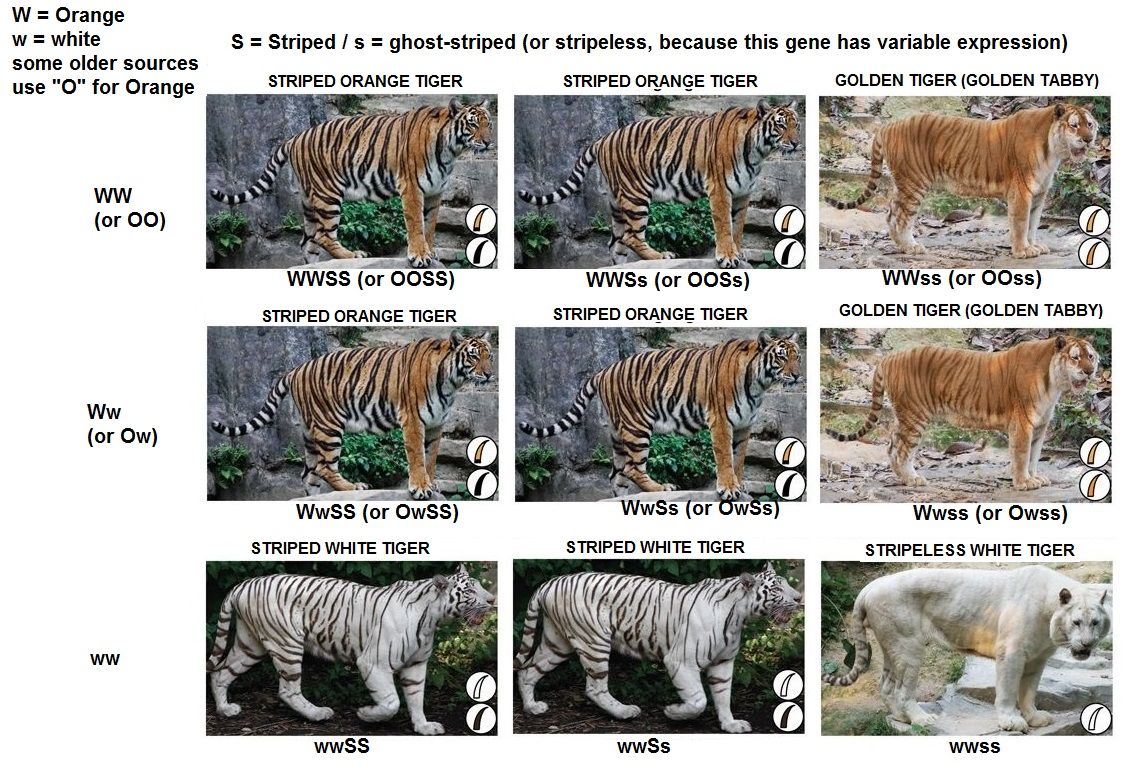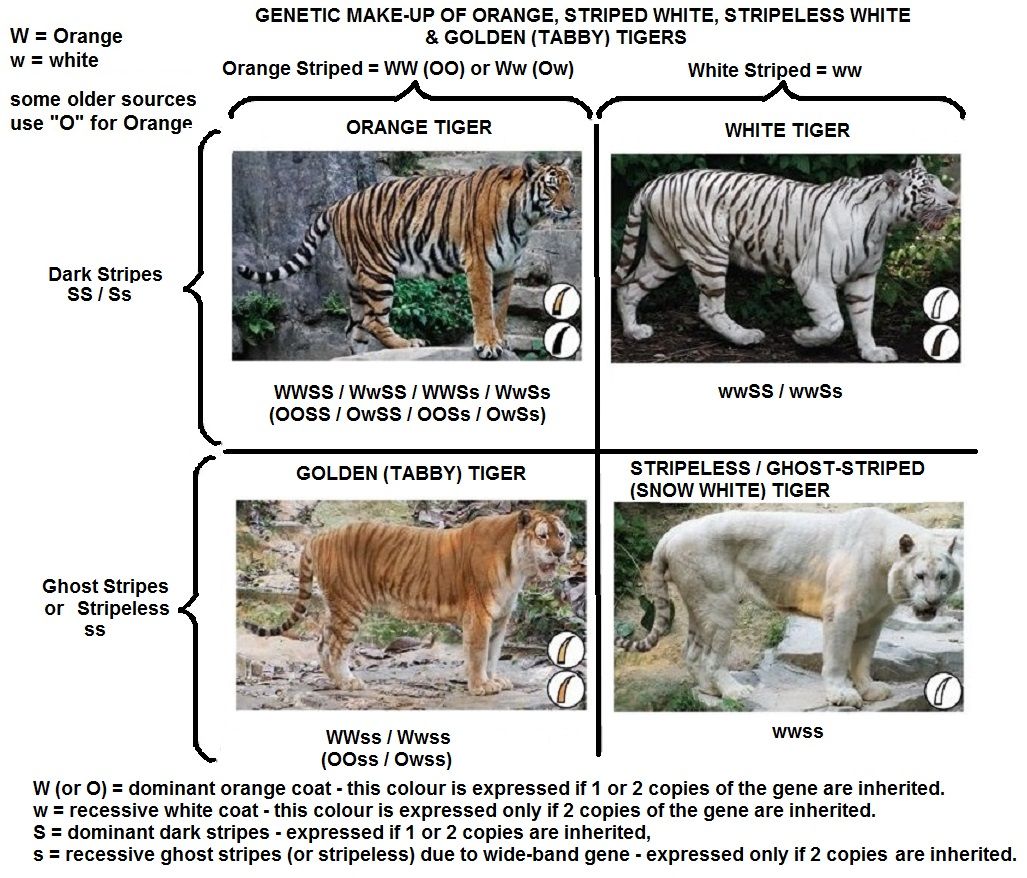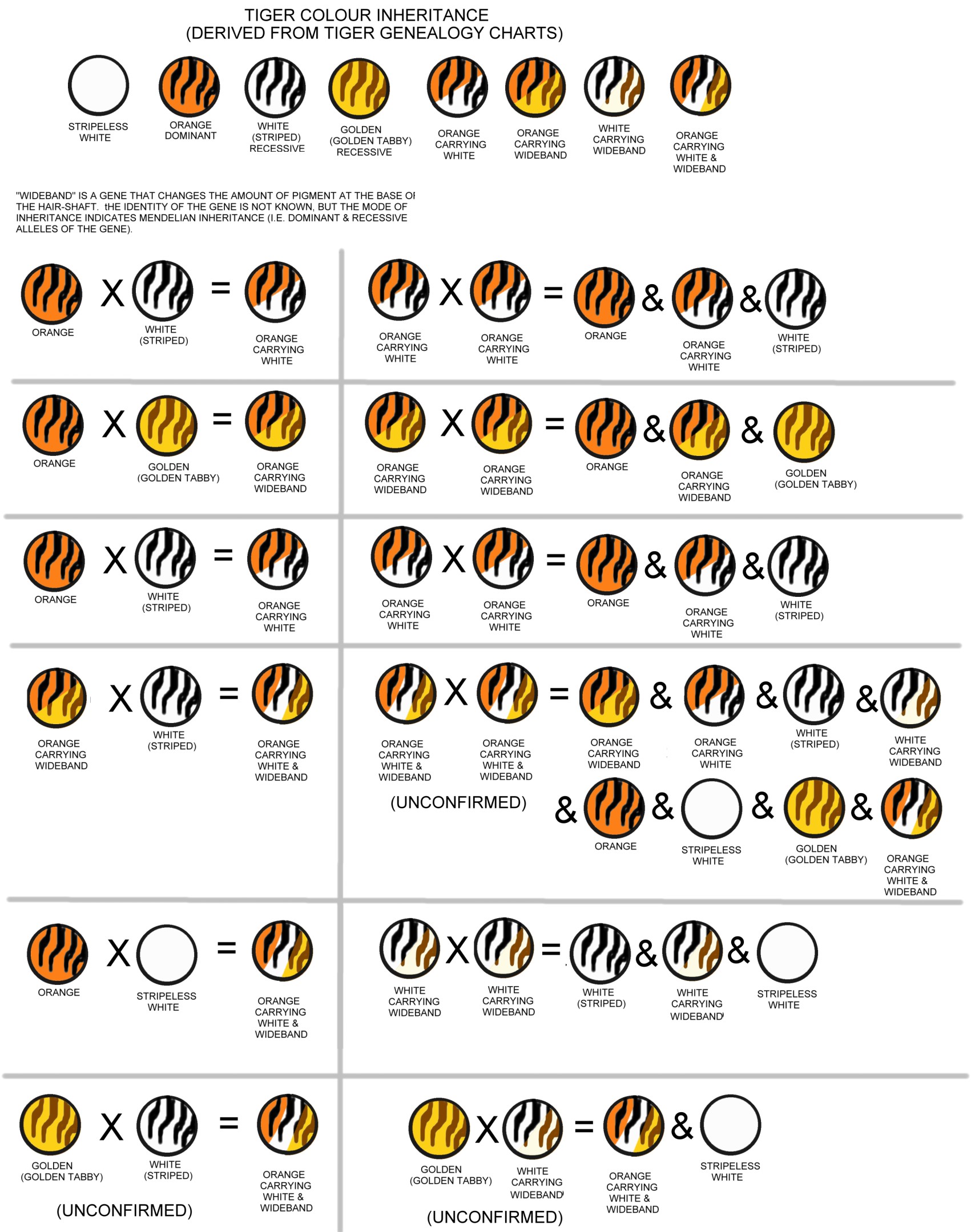
|
COLOUR MORPHS OF TIGERS & |
In the Long Island ocelot Club newsletter 23/2 April 1979, Pat Warren wrote "The Color Genetics of Hybrids" based on her F1 Geoffroy's Cat hybrids and F1 Leopard Cat hybrid. Warren considered the rare "blue tiger", by which she meant the grey-striped white tiger which was not yet common in captivity, might be a wild version of the domestic black-to-blue dilution since a tiger's stripes are normally black. Other authorities believed it was due to the coloupoint gene. The colouration is now known to be similar to the colour inhibitor (chinchilla) gene.

In May 2013, a paper published by a team of Chinese scientists including Dr Shu-Jin Luo of Beijing University, in Current Biology, revealed the genetic basis of white tigers. The team mapped the genes of a family of 16 tigers housed at Chimelong Safari Park. These included both normal and white tigers. They discovered that the white coat colouration is due to a single amino acid change, A477V, in a particular transporter protein known as SLC45A2 (which mediates pigment production). This change inhibits the synthesis of phaeomelanin (red, orange and yellow pigment) (phaeomelanin), but does not inhibit the synthesis of eumelanin (black and chocolate) which explains why white tigers keep their dark stripes. The team noted that white tigers had existed in the wild until the 1950s as a natural and viable colour morph, not handicapped by their colouration, until their extinction at the hands of hunters. They believe that the white tiger is worthy of conservation and reintroduction into the wild because they are part of the tiger's natural polymorphic genetic diversity. The defects found in zoo specimens are not due to the single amino acid change, but due to the excessive inbreeding that has caused other genes to accumulate in breeding stock.
My deductions in the early 2000s, based entirely on analysis of the family trees and knowledge of cat genetics, were confirmed by a letter entitled The Genetics Of Tiger Pelage Color Variations (Cell Research, 10 March 2017), written by Xiao Xu, Gui-Xin Dong etc al. Here are simplified excerpts.
The white tiger coat is due an autosomal recessive gene on the W locus i.e. white tigers are genotype w/w. (I had posited this as “chinchilla” which is the “silver” gene found in domestic cats and responsible for silver tabbies.) The golden colour is another autosomal recessive trait, this one known as wideband, WB, referring to a wider central part of the hair shaft. Golden tigers therefore wb/wb genotype. The stripeless white tigers, which the letter’s authors referred to a snow white tigers, are recessive for both of these genes i.e. w/w, wb/wb. Snow white tigers were produced by several generations of close inbreeding, which often causes recessive genes to “double up”.
In molecular terms, in white tigers, it is the mutation called p.A477V in gene SLC45A2 that switches the background colour from normal orange to white. Like cats, tigers have agouti hairs (zig-zag hairs) with coloured bands as their background colour. 90% of the tiger’s coat comprises these agouti hairs. On orange tigers, the agouti hairs have dark tips and bases and bands of phaeomelanin (red pigment) in between. On golden tigers, the agouti hairs have dark tips and bases, but have much wider bands of pale colour and narrower bands of red pigment inbetween.
Where the stripes are reddish brown rather than black, it appears that the WB gene plays some role in extending the pheomelanin synthesis phase during the hair growth cycle. (I had posited a separate extension gene for this rather than an effect of wide-band, and this may still turn out to be the case). In 2017, the only confirmed mammalian wideband gene was a mutation of the Agouti Signaling Protein (ASIP) gene in deer mice. It hasn’t yet been determined whether the ASIP is the wideband gene of the golden tiger, nor how WB and W interact to create stripeless white tigers. Resolving the feline wideband gene would unravel the genetic basis of all known coat colour morphs in tigers.
The genes MC1R, ASIP, TYR and TYRP1 were not associated with the golden tiger morph. A mutation in a gene called CORIN was found to be specific to golden and stripeless white tigers. CORIN suppresses the agouti pathway. CORIN knockout agouti mice have wider agouti bands in the hair shaft resembling the banding found in the golden tiger. All golden and stripeless white tigers sampled were homozygous for the mutation in the CORIN gene. All orange and striped white tigers sampled had the wild-type version of the gene, but some also carried the recessive mutant version.
Genotype analyses of CORIN p.H587Y and SLC45A2 p.A477V in those individuals confirmed that the individual or combined effect of these two mutations explained the 4 tiger coat colour variations . Wild-type CORIN regulates melanin production by suppressing the activity of ASIP (which causes switching between eumelanin and phaemelanin during hair growth). The p.H587Y mutation might impair the function of CORIN and elongate the working period of ASIP, resulting in the wider bands on the golden tiger hair. Their study demonstrated that CORIN is a feline wideband gene. Because CORIN inhibits ASIP in melanin production, reduced function of CORIN or increased function of ASIP could both cause a wideband effect in mammals, demonstrating that there may be multiple genotypes causing the “wideband” effect in mammals.
Snow white tigers are homozygous for both SLC45A2 p.A477V and CORIN p.H587Y mutations, indicating that the “white tiger mutation” combined with the “golden tiger mutation” may reduce melanin production throughout the whole coat. However, it must be noted that the regulation of ASIP activity by CORIN p.H587Y alone (or along with the effect of the SLC45A2 mutation) is not seem sufficient to fully explain the colour change of stripes in either golden or snow white tigers.

SIMPLE MENDELIAN INHERITANCE OF ORANGE AND WHITE - RATIOS

|
KNOWN COLOUR MORPHS OF TIGERS |
UNCONFIRMED |
|
|
Snow White |
Tawny (orange/normal) |
Blue (maltese) |
|
White (black striped) |
Golden (Golden Tabby) |
Brown or Red (unstriped) |
|
White (grey striped) |
Black (melanistic) |
|
|
White (red striped) |
Black (pseudo-melanistic) |
|
|
White (cream striped/ghost striped) |
Brown/beige (brown striped) |
|
|
Albino (pink-eyed) |
|
|
|
POSSIBLE GENE EFFECTS INVOLVED IN WHITE AND GOLDEN TIGERS |
||||
|
Gene: |
Phaeomelanin Inhibitor or "White Switch" |
Red |
Colour Dilution |
Wide Band |
|
Effect: |
Turns hair shafts silver/white on background colour areas |
Produces reddish pigment instead of black |
Fades pigment i.e. black to grey, red to cream |
Changes width of colour bands on hair shaft. |
|
White with black stripes |
YES |
|
|
|
|
White with grey stripes |
YES |
|
? |
|
|
White with red/brown stripes |
YES |
? |
|
|
|
White with cream stripes |
YES |
? |
? |
|
|
White with ghost stripes |
YES |
|
? |
YES |
|
Snow White |
YES |
? |
? |
YES |
|
Golden Tabby |
May be carrier |
|
|
YES |
|
Pale Golden Tabby |
May be carrier |
? |
? |
YES |
|
Beige + brown stripes |
May be carrier |
? |
? |
POSSIBLY |


Textual content is licensed under the GFDL.
For more information on the genetics of colour and pattern:
Robinson's Genetics for Cat Breeders & Veterinarians 4th Ed (the current version)
Genetics for Cat Breeders, 3rd Ed by Roy Robinson (earlier version showing some of the historical misunderstandings)
Cat Genetics by A C Jude (1950s cat genetics text; demonstrates the early confusion that chinchilla was a form of albinism)
For more information on genetics, inheritance and gene pools see:
The Pros and Cons of Inbreeding
The Pros and Cons of Cloning
For more information on anomalous colour and pattern forms in big cats see
Karl Shuker's "Mystery Cats of the World" (Robert Hale: London, 1989 - some of the genetics content is outdated)
|
BACK TO HYBRID & MUTANT BIG CATS INDEX |